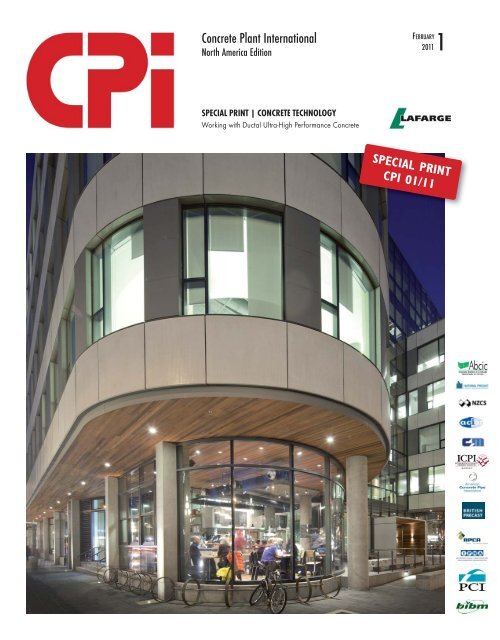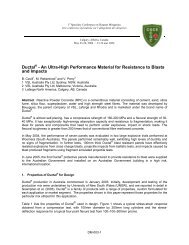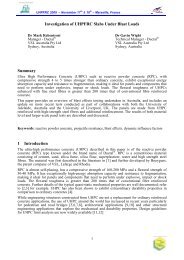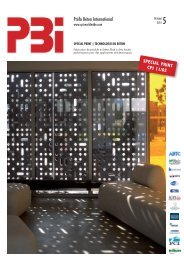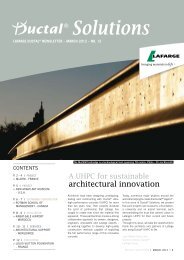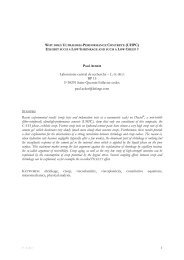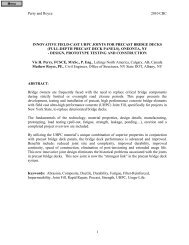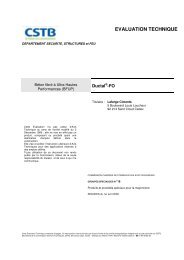CPI - February 2011 - Working with Ductal® UHPC
CPI - February 2011 - Working with Ductal® UHPC
CPI - February 2011 - Working with Ductal® UHPC
Create successful ePaper yourself
Turn your PDF publications into a flip-book with our unique Google optimized e-Paper software.
Concrete Plant International<br />
North America Edition<br />
FEBRUARY<br />
<strong>2011</strong>1<br />
SPECIAL PRINT | CONCRETE TECHNOLOGY<br />
<strong>Working</strong> <strong>with</strong> Ductal Ultra-High Performance Concrete<br />
SPECIAL PRINT<br />
<strong>CPI</strong> 01/11
CONCRETE TECHNOLOGY<br />
Lafarge North America, T2W 4Y1,Calgary, Alberta, Canada<br />
<strong>Working</strong> <strong>with</strong> Ductal Ultra-High Performance Concrete<br />
Introduced to the world in the mid-90’s, Ductal ® Ultra-High-Performance Concrete (“<strong>UHPC</strong>”) has come a long way. With its unique combination<br />
of ductility, strength, durability and aesthetics, precast elements can have thinner sections and longer spans that are lighter, more grace ful<br />
and innovative (compared to conventional concrete). Highly moldable, it replicates form materials <strong>with</strong> amazing precision. Compressive<br />
strengths reach up to 200 MPa and flexural strengths up to 40 MPa, providing improved durability and impermeability against corrosion,<br />
abrasion and impact. Furthermore, it is sustainable. <strong>UHPC</strong> structures are expected to have an extended service life, resulting in less environmental<br />
impact over time.<br />
The purpose of this article is to help precasters learn about Ductal <strong>UHPC</strong> and the potential opportunities that exist through production of innovative<br />
products and solutions that compliment their existing precast products and businesses. The following article is an introduction to <strong>UHPC</strong><br />
and the first in a series of related articles that <strong>CPI</strong> will publish in future issues.<br />
Vic H. Perry, Peter J. Seibert, Lafarge,<br />
North America<br />
As one of the pioneers in Ultra-High<br />
Performance Concrete (<strong>UHPC</strong>), Lafarge<br />
worked closely <strong>with</strong> Bouygues in the early<br />
90’s to explore new possibilities in ad vanced<br />
concrete technologies. After ten years of<br />
research, they produced an innovative<br />
material <strong>with</strong> unique technological performances.<br />
The main principle of this technology<br />
is based on systematic elimination of inherent<br />
weaknesses associated <strong>with</strong> conventional<br />
concrete. The ductile behaviour of this<br />
material is a first for concrete, <strong>with</strong> the<br />
capacity to deform and support flexural<br />
and tensile loads, even after initial cra -<br />
ck ing. These performances are the result of<br />
improved micro-structural properties of the<br />
mineral matrix, especially toughness and<br />
control of the bond between the matrix and<br />
the fiber.<br />
Today, Ductal is a family of <strong>UHPC</strong> products.<br />
Two types of fibers are used to make Ductal<br />
Sanderling Drive Pedestrian Overpass, Canada<br />
products: high carbon metallic or poly-vinyl<br />
alcohol (PVA) fibers. The fiber and chemical<br />
formulation is customized to best fit the<br />
application requirements. When selecting a<br />
Ductal product, determining factors include<br />
strength, ductility and rheology requirements,<br />
exposure to corrosive agents, desired<br />
aesthetics and exposure to human contact.<br />
The optimization of granulars, the fibers<br />
and admixtures provides a very low porosity<br />
in a cement-based mineral granulometric<br />
matrix. The premix components consist of<br />
granular material <strong>with</strong> a diameter less than<br />
1 mm, and a highly reduced water-cement<br />
ratio (less than 0.25, depending on the type<br />
of Ductal formulation). Elimination of<br />
coarse aggregates, along <strong>with</strong> the granular<br />
gradation and fiber aspect ratio, facilitates<br />
a high fiber content and isotropic dispersion.<br />
There is almost no carbonation or penetration<br />
of chlorides and sulfates and a high<br />
resistance to acid attack. Its superior durability<br />
characteristics are due to a combina -<br />
tion of fine powders, selected for their relative<br />
grain size and chemical reactivity. The<br />
net effect is a maximum compactness and a<br />
small, disconnected pore structure. Ductal<br />
has almost no shrinkage or creep, making it<br />
very suitable for prestressed applications.<br />
The use of this material for construction is<br />
simplified through the elimination of reinforcing<br />
steel and its ability to be virtually<br />
self-placing or dry-cast.<br />
Overall, Ductal solutions can offer advantages<br />
such as speed of construction, im -<br />
proved aesthetics, superior durability and<br />
impermeability against corrosion, abrasion<br />
and impact – which translates to reduced<br />
main tenance and a longer structural life<br />
span.<br />
Over the years, Ductal has been subjected<br />
to a significant amount of rigorous testing<br />
and field trials. In the USA, Canada,<br />
France, Japan and Australia, several offi -<br />
cial documents now prescribe Ductal for<br />
building, infrastructure, manufacturing,<br />
artis tic and industrial designs. Today, this<br />
material is used for a variety of applications<br />
such as bridge beams and decks, joint fill,<br />
solid and perforated wall panels/facades,<br />
urban furniture, louvres, stairs and floors,<br />
pipes, piles, marine structures and others.<br />
Target markets<br />
Ductal has been used successfully by many<br />
precasters in ways that compliment their<br />
existing businesses. Due to its advanced<br />
characteristics (compared to conventional<br />
concrete) including durability, strength,<br />
reduced weight and aesthetics, Ductal has<br />
opened the door to new opportunities for<br />
precasters in the structural and architectural<br />
markets.<br />
2<br />
<strong>CPI</strong> – Concrete Plant International – 1 | <strong>2011</strong><br />
www.cpi-worldwide.com
CONCRETE TECHNOLOGY<br />
Vic H. Perry received his Bachelor of Civil Engineering <strong>with</strong> Distinction in 1978 and Master of Applied Science<br />
in Structural Engineering in 1984 from Dalhousie University in Nova Scotia, Canada. In 1999, he was bestowed a<br />
Fellow of the Canadian Society for Civil Engineering (CSCE) and elected President of the CSCE in 2010. Since 1997,<br />
Vic has been involved in the development of Ductal (<strong>UHPC</strong>), initially as Director of Marketing (Ductal) for the<br />
Lafarge Group in Paris, France and since 2001, as Vice-President & General Manager Ductal, Lafarge North<br />
America, in Calgary, Canada.<br />
Vic.Perry@Lafarge-na.com<br />
Peter J. Seibert obtained his Bachelor of Civil Engineering from the University of Toronto in 1996, a Masters in<br />
Civil Engineering from Queen’s University, Kingston, Ontario in 1998 and an MBA from Wilfrid Laurier University,<br />
Waterloo, Ontario in 2003. Based in Calgary, Canada, Peter is the Technical Director for Ductal (<strong>UHPC</strong>), responsible<br />
for the manufacturing, supply chain, quality control and technical aspects of Ductal throughout North America<br />
since 2006.<br />
Peter.Seibert@Lafarge-na.com<br />
to their design efficiency, fast installation<br />
and low initial costs. However, the standard<br />
grouting material in the joints is often the<br />
first part of the bridge to fail due to contin -<br />
uous highway impacts causing the joints to<br />
leak. Recent applications of in-field casting<br />
of Ductal in the joints have resulted in the<br />
joints being the strongest link in the precast<br />
bridge system. This concept creates new<br />
opportunities for precasters who can now<br />
offer a new solution for bridge owners by<br />
utilizing their existing precast product offer -<br />
ing in combination <strong>with</strong> Ductal. Manufac -<br />
turing of deck panels or box girders in a<br />
precast plant results in high quality concrete<br />
elements and, when combined <strong>with</strong> Ductal<br />
joint fill, the precaster will be able to offer<br />
an innovative, extremely durable, high quality<br />
bridge deck for the bridge owner and<br />
the general public.<br />
The Atrium, Canada<br />
Structural market<br />
According to the Federal Highway<br />
Administration (FHWA) National Bridge In -<br />
ven tory (NBI) Study, approximately<br />
156,000 bridges in the USA are structurally<br />
deficient or functionally obsolete. State,<br />
provincial and municipal engineers are seeking<br />
new ways to build better bridges, there -<br />
by reducing maintenance costs that are<br />
diverted from capital budgets required for<br />
building much needed highways and<br />
bridges. Therefore, the FHWA launched a<br />
program, “The Bridge of the Future”, to<br />
help drive new solutions for building<br />
bridges.<br />
Implementation of new technologies in the<br />
bridge sector has been a long journey due<br />
to the conservative nature of this segment.<br />
Highway bridge engineers, bestowed <strong>with</strong><br />
guardianship of the public money and safety,<br />
have always demonstrated the technology<br />
before using it. In many applica tions,<br />
prototypes were manufactured to test and<br />
validate the bridge design concept. In addition,<br />
new bridge sections and solutions<br />
have been developed in North America.<br />
One of the best Ductal <strong>UHPC</strong> applications<br />
which utilizes existing precast products for<br />
the bridge market involves a unique joint fill<br />
solution for precast deck panels or precast<br />
box-girders. Historically, these elements were<br />
preferred by owners for bridge systems due<br />
Precast Ductal waffle panels also take<br />
advantage of the material’s high durability<br />
aspects. For this design concept, full-depth<br />
precast deck panels must be 8“ (200 mm)<br />
to ensure deck stiffness, leaving a 2.5“ (62<br />
mm) uniform deck <strong>with</strong> 5.5“ two-way ribs.<br />
The precast panels are then jointed togeth -<br />
er in the field using Ductal joint fill. In 2010,<br />
the Iowa Department of Transpor tation<br />
requested <strong>UHPC</strong> waffle deck panels for a<br />
bridge project <strong>with</strong> <strong>UHPC</strong> joints.<br />
Innovative, new bridge girder sections<br />
made <strong>with</strong> <strong>UHPC</strong> have been developed in<br />
recent years. In particular; the pi-girder<br />
(<strong>with</strong> a cross-section that resembles the<br />
Greek symbol, “π”), resulting in a com -<br />
bined section of girder and built-in precast<br />
deck. The first bridge to use these <strong>UHPC</strong> pigirders<br />
was installed in North America in<br />
2009. This highly optimized girder section<br />
may also open new opportunities for precasters.<br />
To date, Ductal has been used for three<br />
pedestrian bridges in Canada where the<br />
architecture of the structure was the main<br />
driver (besides strength and durability).<br />
Examples of other structural elements that<br />
have been produced in Ductal <strong>UHPC</strong> are<br />
piles, pipes and protective cladding systems<br />
for infrastructures in marine environ -<br />
ments. For each of these applications, precasters<br />
were able to use and slightly modify<br />
their existing plant equipment and formworks<br />
in order to offer a more optimized<br />
precast section which utilizes the material’s<br />
strength and durability characteristics.<br />
www.cpi-worldwide.com <strong>CPI</strong> – Concrete Plant International – 1 | <strong>2011</strong> 3
CONCRETE TECHNOLOGY<br />
Ductal waffle deck panel, USA<br />
Jakway Park Bridge pi-girders, USA<br />
Architectural market<br />
Due to Ductal’s plastic and hardened prop -<br />
erties, plus the elimination of rebar, pre -<br />
casters can achieve complex, architectural<br />
shapes that are extremely durable, cost<br />
effective and require little maintenance. The<br />
material replicates textures, form and shape<br />
<strong>with</strong> high precision and can be produced in<br />
a range of long-lasting colours. This material<br />
works well for new, innovative concrete<br />
applications and supports new trends in<br />
architecture: purity of line, delicacy, enhance -<br />
ment of texture and mineral bias.<br />
With Ductal, precasters can offer new, innovative<br />
building envelope solutions for creative<br />
architects. For instance: structural, decorative<br />
perforated facades in mesh or lattice-style<br />
designs; ultra-thin, lightweight panels<br />
<strong>with</strong> large surface areas and perforation<br />
rates that exceed 50% and full facades<br />
<strong>with</strong> complex shapes, curvatures and tex -<br />
tures.<br />
Ductal has also been used in a variety of<br />
urban furnishings. Because of its strength<br />
and minimalistic use, impact resistance,<br />
dura bility and low maintenance requirements,<br />
it is an excellent alternative to traditional<br />
materials. New sculptures, benches,<br />
bollards and street furnishings have been<br />
added to product offerings of traditional<br />
precast manufacturers. As well, interior<br />
designers and precasters may also create<br />
new, contemporary, lightweight, coloured<br />
and textured products such as chairs, stairs,<br />
and tiles for floors and walls.<br />
Business Plan for <strong>UHPC</strong> Applications<br />
For manufacturers to successfully commercialize<br />
precast elements using Ductal, a<br />
business plan for the proposed solution<br />
must be developed and validated. Once<br />
precasters understand the material’s technical<br />
properties, they may seek “problems that<br />
require a solution” which, in turn, must be<br />
validated by an economic analysis (compared<br />
to current alternatives).<br />
When looking at the pricing structure for<br />
<strong>UHPC</strong>, precasters should keep in mind that<br />
a new, innovative solution <strong>with</strong> superior<br />
technical characteristics will result in a very<br />
different look and size compared to elements<br />
produced <strong>with</strong> alternative/traditional<br />
Thiais Bus Shelter, France<br />
Shawnessy LRT Station, Canada<br />
4<br />
<strong>CPI</strong> – Concrete Plant International – 1 | <strong>2011</strong><br />
www.cpi-worldwide.com
CONCRETE TECHNOLOGY<br />
materials such as wood, metals or conventional<br />
concrete. The economics of the entire<br />
innovative solution must be validated; it is<br />
not simply a unit price comparison.<br />
Ductal, like metals or conventional concrete,<br />
has a wide range of products <strong>with</strong> a<br />
range of unit selling prices but is used in different<br />
ways. The range in unit price is be -<br />
tween concrete and metals and, when used<br />
in an optimized manner, it provides solu -<br />
tions that are extremely durable and cost<br />
competitive. Comparing <strong>UHPC</strong> <strong>with</strong> ready<br />
mix concrete which is sold in North Ame r -<br />
ica between $100/m 3 to $180/m 3 , cost<br />
can vary from $2,500/m 3 to $4,500 /m 3 ,<br />
depending on the formulation <strong>with</strong>in the<br />
<strong>UHPC</strong> family of products for various applications.<br />
This pricing structure also varies in<br />
different markets and regions around the<br />
world.<br />
This pricing comparison may seem interesting<br />
however, when buying various types of<br />
steel, an order of magnitude of $8,000/ m 3<br />
for black steel and $30,000/m 3 for stainless<br />
steel is evident. This clearly shows that<br />
the entire economics of the finished <strong>UHPC</strong><br />
solution (including material costs, manufacturing<br />
costs, distribution costs and market<br />
economics) must be considered when<br />
reviewing the pricing structure which should<br />
not be based on unit pricing of materials. It<br />
is higher priced when compared <strong>with</strong> conventional<br />
concrete but the volume of material<br />
required is greatly reduced and it provides<br />
many superior results/benefits and<br />
cost effective solutions that conventional<br />
concrete cannot.<br />
Development of the business plan also<br />
requires that precasters review their distribution<br />
and promotion strategies since they are<br />
the experts when it comes to understan ding<br />
the local markets, accessibility and market<br />
tolerance. In addition, they will de velop<br />
their own value proposition for any new,<br />
innovative solutions. After the business plan<br />
has been completed, prototypes of the proposed<br />
solution must be tested, opti -mized<br />
and certified. Successful <strong>UHPC</strong> commercialization<br />
relies on the above business strategies,<br />
in order to create continuous production<br />
and sales.<br />
Commercial and technical partnership<br />
<strong>with</strong> precasters<br />
Ductal <strong>UHPC</strong> is a full-fledged technological<br />
solution that creates new opportunities for<br />
precasters to develop and expand their<br />
area of expertise and business. In order to<br />
use the material for a specific application,<br />
the precaster must first obtain a Ductal sublicense.<br />
Then, Lafarge will provide support<br />
and necessary training which will allow<br />
them to gradually master the technology<br />
and commence production of a profitable<br />
solution. For many Ductal projects or product<br />
applications, the experts at Lafarge can<br />
also facilitate important liaisons be -tween<br />
the precaster, owners, engineers, archi tects<br />
and academics worldwide.<br />
For many new, innovative applications, prototype<br />
testing is required, therefore Lafarge<br />
provides guidance based on previous<br />
experience and product applications. By<br />
taking advantage of the material’s technical<br />
characteristics, precasters can optimize<br />
a new, innovative <strong>UHPC</strong> solution <strong>with</strong> a<br />
design, size or texture that will be very different<br />
compared to alternative products<br />
made <strong>with</strong> traditional materials.<br />
For a successful partnership, Lafarge contributes<br />
its materials expertise and commer -<br />
cial know-how, while the precasters provide<br />
their technical skills in the industrial process<br />
and knowledge of their desired markets.<br />
The success of innovative projects requires<br />
regular study and development of original<br />
processes. Hindsight and Lafarge's experiences<br />
<strong>with</strong> the many different Ductal applications<br />
and products allows them to pro -<br />
vide the best guidance and suggest innova -<br />
tive methods for using the material.<br />
Future Articles in <strong>CPI</strong><br />
Lafarge will publish several articles on<br />
<strong>UHPC</strong> in future issues of <strong>CPI</strong>, on the follow -<br />
ing topics:<br />
· Equipment and production techniques<br />
using Ductal<br />
· Manufacturing of <strong>UHPC</strong> structural<br />
products<br />
· Manufacturing of <strong>UHPC</strong> architectural<br />
products<br />
· Manufacturing of <strong>UHPC</strong> artisan products<br />
<br />
FURTHER INFORMATION<br />
Museum of Modern Art, France<br />
Lafarge North America<br />
10655 Southport Road SW., Suite 1200<br />
T2W 4Y1,Calgary, Alberta, Canada<br />
T +1 403 271 9110<br />
F +1 403 278 7420<br />
ductal@lafarge-na.com<br />
www.ductal-lafarge.com<br />
www.cpi-worldwide.com <strong>CPI</strong> – Concrete Plant International – 1 | <strong>2011</strong> 5


